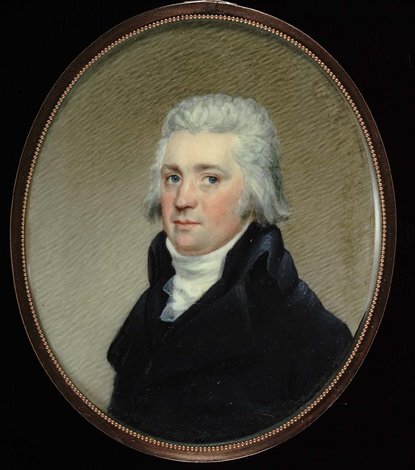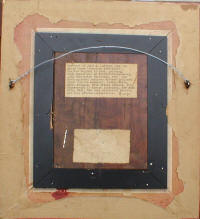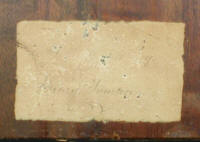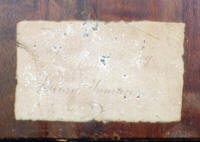Henry Inman and
Edward Greene Malbone ~ portraits of the John Corliss family late 18th and early 19th century.
|
Interesting
hereditary or genetic comparisons of John A Corliss, Esq. painted by *Henry Inman, and his
(likely) father and
mother in two miniatures painted by *Edward Malbone. Note strong facial
comparisons of forehead, mouth and chin to John Corliss senior. Eyes of John A
Corliss are brown and identical to his mother's eyes, and their noses
are identical also. (See mother's portrait photo below father's
miniature). The Corliss family dates to
George
Corliss, the founder of the family in America, who was born in the
county of Devonshire, England, about 1617, he came to this country in
1639. Many descendants
were (and still
are) prominent New England families, many from Rhode Island. John
Corliss (senior) operated a sea shipping company sailing out of Newport Rhode Island
the first quarter of the 19th century.
*It is
sad to note that both these prominent American artists,
Inman and Malbone, lived less than 45 years.
Following the portraits below are germane excerpts from articles found
on the internet mentioning John (A) Corliss and Antiques Magazine
articles mentioning both artists and John Corliss and his wife. Also a
bio of Henry Inman and an excerpt from the Corliss family tree
mentioning a John Corliss B 1801 D 1869 which may be this
John A Corliss. Also comparisons of the
verso of Inman's Corliss portrait and the verso of two other Inman
works.
|
NOTE: Persons with any information on this Johns A Corliss
or any comments on this study or portrait are very welcome
and you may comment via
admin@beamsco.com please mention Inman or Corliss in the
subject line in your email.. |
|
Henry Inman
1801 ~ 1845 American Artist
Oil on canvass on board. exposed oil size approx 6 1/2 by 8 inches
Portrait of John A Corliss Esq. Circa 1830
By Henry Inman
In a private collection
|
John A Corliss Esq.
By Henry Inman
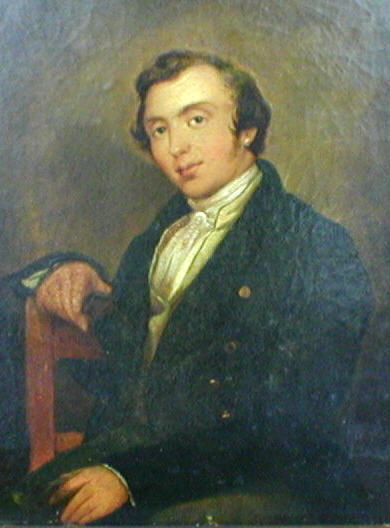
|
 |
|
Edward Greene Malbone American artist 1777 - 1807
Miniature Watercolor on Ivory size approx 2 1/2 by 3 1/2 inches
Portrait of John Corliss Circa
1795
By
Edward Greene Malbone
In the Smithsonian Institute
|
Mrs. John Corliss (Susannah Condé Russell) 1795
By
Edward Greene
Malbone
 |
|
Henry Inman Bio:
Henry Inman: Born at Utica, New York, Henry Inman moved with his parents to
New York City, where he began a seven-year apprenticeship under portraitist John
Wesley Jarvis. In 1824 Inman established his own studio in the city. Two years
later he helped to found the National Academy of Design, serving as its vice
president until 1831, when he moved to Philadelphia to become a partner in the
lithographic firm of Childs and Inman. He returned to New York City in 1834 and
enjoyed considerable success over the next ten years as a portrait painter,
including among his sitters President Martin Van Buren and Chief Justice John
Marshall. Inman's last important commission took him to England in 1844-45 to
paint the portraits of Lord Macaulay and of the poet William Wordsworth. He died
within a few months of his return to the States.
While abroad, Inman painted the portrait of Scottish nobleman Sir William
Drummond Stewart (below), who had undertaken an expedition into the American
West in 1837 accompanied by Alfred Jacob Miller, a Baltimore artist. Miller
produced a number of works for Stewart at Murthly Castle in Scotland, where he
met Inman. A collection of Miller's watercolors and the Inman portrait of
Stewart ultimately were purchased by Joslyn Art Museum. Stewart's portrait is
one of the last that Inman painted and, arguably, one of the best.
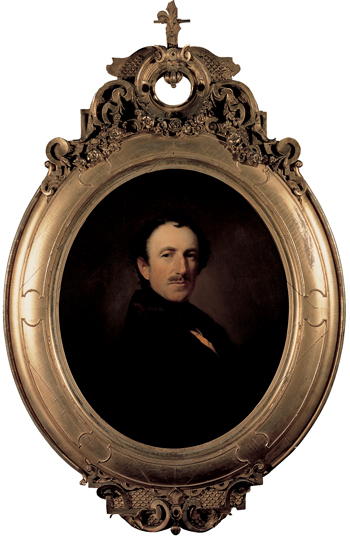 |
Other Inman works


Left:
Sir William D Stewart |


President Martin Van Buren
(above) |
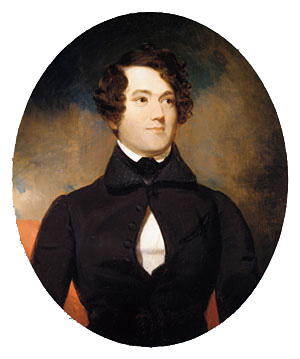
Henry G. Stebbins
|
Some portrait photos & data from
http://www.joslyn.org/collections-and-exhibitions/permanent-collections/american/henry-inman-portrait-of-william-drummond-stewart/
Henry G. Stebbins
Henry Inman (American, Utica, New York 1801–1846 New York City)
Date: 1838
Medium: Oil on canvas
Dimensions: 30 x 24 in. (76.2 x 61 cm)
Classification: Paintings
Credit Line: Bequest of Josephine S. Stebbins, 2000
Accession Number: 2001.269
Signatures, Inscriptions, and Markings
Inscription:
on lining on reverse, twice]: H. Stebbins Esq. / Painted by H. Inman / N. York
1838
[This inscription on an old lining canvas appears to reproduce an
inscription on the original canvas back
Provenance Descended in the family of the sitter to the donor, by bequest.
NOTE: the Inman painting of "John A Corliss Esg." is inscribed
on
verso similar to the painting above of Stebbins.
Oil on canvass and mounted on board: 6 1/2" X 8"
See photos below of verso and original label marked John A Corliss, Esq. by
Henry Inman, and a later collection label affixed at top referring to the bottom
inscription again (very faint label):
Click photos to enlarge...
|
Persons having an interest or further
information on this branch of the Corliss family, especially John A
Corliss and this recently
discovered Inman portrait are invited to email us
at admin@beamsco.com
(the
Researchers and Webmasters of this
webpage) |
More Research information...
HENRY INMAN "Portrait of the Artist's Daughter, Mary"

-
Sold Date:
10/21/2004
-
Channel:
Auction House
-
Source:
Shannon's Fine Art Auctioneers
-
Category:
Fine Art
Property of a Corporate Collection American (1801-1846)
oil on canvas on
board, 5 x 7 1/4,
signed lower left and dated 1843. Provenance: M. Knoedler & Co., New York, New
York; Mrs. Norman B. Woolworth, Maine; Sarah Mleczko Fine Art, New York.
Exhibited: Portland Museum of Art, Portland, Maine, n.d.; The National Portrait
Gallery, Washington, D.C., April 3 - August 2, 1987.
The above Inman Oil on canvas on board is of similar
construction and size to the John A Corliss Esq. painting
Excerpt from the a
genealogy found online
“56 CORLISS FAMILY RECORD.
Children
:
1010. A
daughter. May 18, 1797, d. May 21, 1797.
(2040)
1011. Tristram, June "^13, 1798.
1012.
John, Jan. 9, 1800. d. Mar. 1, 1800.
(2044) 1013.
* John, b. Feb. 12, 1801, d. Jan. 9, 1869e
"
*This John Corliss may be the sitter in Inman’s portrait, the d & b dates are
certainly right…Inman likely painted John A Corliss around 1830-35 which would
make the sitter around 30-35 years, which age the sitter appears to be.
This following Antiques Magazine article – makes reference to John Corliss (perhaps father or
grandfather 0f John A Corliss?) Sitting for a miniature in 1795 for artist
Edward Greene Malbone...
“Portrait
miniatures in the New Republic”
April 2009 | The stunning events of July 1804 were almost unfathomable for the
citizens of the new American republic. One Founding Father had fatally wounded
another. Alexander Hamilton was dead and Aaron Burr would be indicted for
murder. The duel and its aftermath marked a turning point in American culture.
Five
days before the Burr-Hamilton duel, Edward Greene Malbone arrived for a week’s
stay in New York. Considered the finest miniaturist in the United States,
Malbone was attractive, popular, already exceedingly successful, and only
twenty-six years old. As Hamilton’s massive funeral snaked up Broadway on July
14, he was meeting twenty-five year-old Anson Dickinson for the first time. A
fledgling artist, Dickinson had commissioned Malbone to paint his miniature,
hoping to learn by watching the more experienced artist at work (Fig. 1).1 So
absorbed was Malbone in the painting “that he neither paused himself to view the
pageant nor suffered his sitter to do so.”2



Around the corner on Wall Street, twenty-five-year-old Joseph Wood and
twenty-three-year-old John Wesley Jarvis had recently formed an artistic
partnership. All four artists, soon to be fast friends, were young, handsome,
and ridiculously talented. Within three years, Malbone would be dead, but before
that, the creative cross-pollination between these four young artists would
allow them to develop a singular style that could never be mistaken for anything
other than uniquely American.
So
pervasive was their influence that when he came on the scene in 1818, the
academically trained Daniel Dickinson (1795–c. 1866), younger brother of Anson,
still turned to the model established by the quartet many years before. “I
adopted a style between my brother Anson’s, Malbone’s and J. Wood’s, fifteen
years after my brother commenced,” he wrote.3
In
the decades since the 1740s American portrait miniatures had changed little.
They were small, dark, and resembled provincial British works, which, indeed,
they were. The most successful artists were still either British (Archibald
Robertson [1765–1835], Robert Field [c. 1769–1819]) or had trained there
(Charles Willson Peale [1741–1827]). Their American patrons, eager for what was
familiar, did not encourage improvement.
That
was about to change.
Edward Greene Malbone
Leaving his family in Newport, Rhode Island, to establish himself as an artist
in Providence, Edward Greene Malbone struck out on his own in 1794 at the age of
seventeen. His earliest miniatures of 1794 and 1795 followed a standard English
formula of placing the sitter in front of red drapery. Though he was painting on
ivory, the young artist was not yet accomplished enough to make use of the
material’s luminosity. The works are characterized by opaque watercolors and
strong outlines (see Fig. 2).
Malbone advanced swiftly. By the end of 1795 his style had changed completely.
The red drapery disappeared and, as illustrated in his portraits of
*John
Corliss and his wife Susannah (nee Russell) of Providence (Smithsonian American
Art Museum, Washington), backgrounds were strongly hatched on a diagonal".
*may
be John A Corliss’s Father & Mother?
 |
 |
Mr. John Corliss 1795
By Edward Greene Malbone
Born: Newport, Rhode Island 1777
Died: Savannah, Georgia 1807
watercolor on ivory
sight 2 7/8 x 2 3/8 in. (7.3 x 6.0 cm) oval
Smithsonian American Art Museum
3rd Floor, Luce Foundation Center
1980.29.2 |
Mrs. John Corliss (Susannah Condé Russell) 1795
Edward Greene Malbone
Born: Newport, Rhode Island 1777
Died: Savannah, Georgia 1807
watercolor on ivory
sight 2 7/8 x 2 3/8 in. (7.3 x 6.0 cm) oval
Smithsonian American Art Museum -Museum purchase 1980.29.2
Smithsonian American Art Museum
3rd Floor, Luce Foundation Center |
Antiques
Magazine article…”New York style, a new generation”
Henry Inman
Young Henry Inman walked into a fortuitous situation when, in 1814, he signed on
as Jarvis’s apprentice. Equally fond of joking and pranks, and showing enormous
promise as an artist, Inman spent a happy seven years with his master. Together
they traveled from Boston to New Orleans. By the end of his service, Inman was
an accomplished artist with important connections and amusing tales.
Upon
striking out on his own in 1821, Inman took on Thomas Seir Cummings as his
apprentice, and by 1824 they were partners, often finishing and signing works
together (see Fig. 16). Dunlap recorded, however, that “Inman devoted himself
almost exclusively to oil painting, leaving Cummings, in the year 1827, the best
instructed miniature painter in the United States.”23
Learning by example of what not to do, this new generation of New York
artists—Rogers, Inman, and Cummings—tutored by the erratic geniuses Jarvis and
Wood were the first to approach art as a business.24 They had stable marriages,
sturdy families, and strong work ethics. All three became founding members of
the National Academy of Design. Cummings would teach miniature painting there
for more than thirty years, additionally serving as professor of the arts of
design at the College of the City of New York. For the next three decades,
virtually every young miniaturist passing through New York in search of academic
training would be touched by Cummings. In 1834 he wrote: “Works in miniature
should possess the same beauty of composition, correctness of drawing, breadth
of light and shade, brilliancy, truth of colour, and firmness of touch, as works
executed on a larger scale” (see Fig. 17).25 Cummings, more than any other
artist of his generation would influence the next generation of New York
miniaturists. The look and technique that had evolved from Malbone to Dickinson,
Jarvis, and Wood, then to Rogers and Inman, and subsequently to Cummings, was,
by 1830, recognized as the uniquely American “National Academy” style...
Research & Data compiled by BEAMSCO from many online resources, for which
excerpts & photos we gratefully acknowledge and give thanks.



